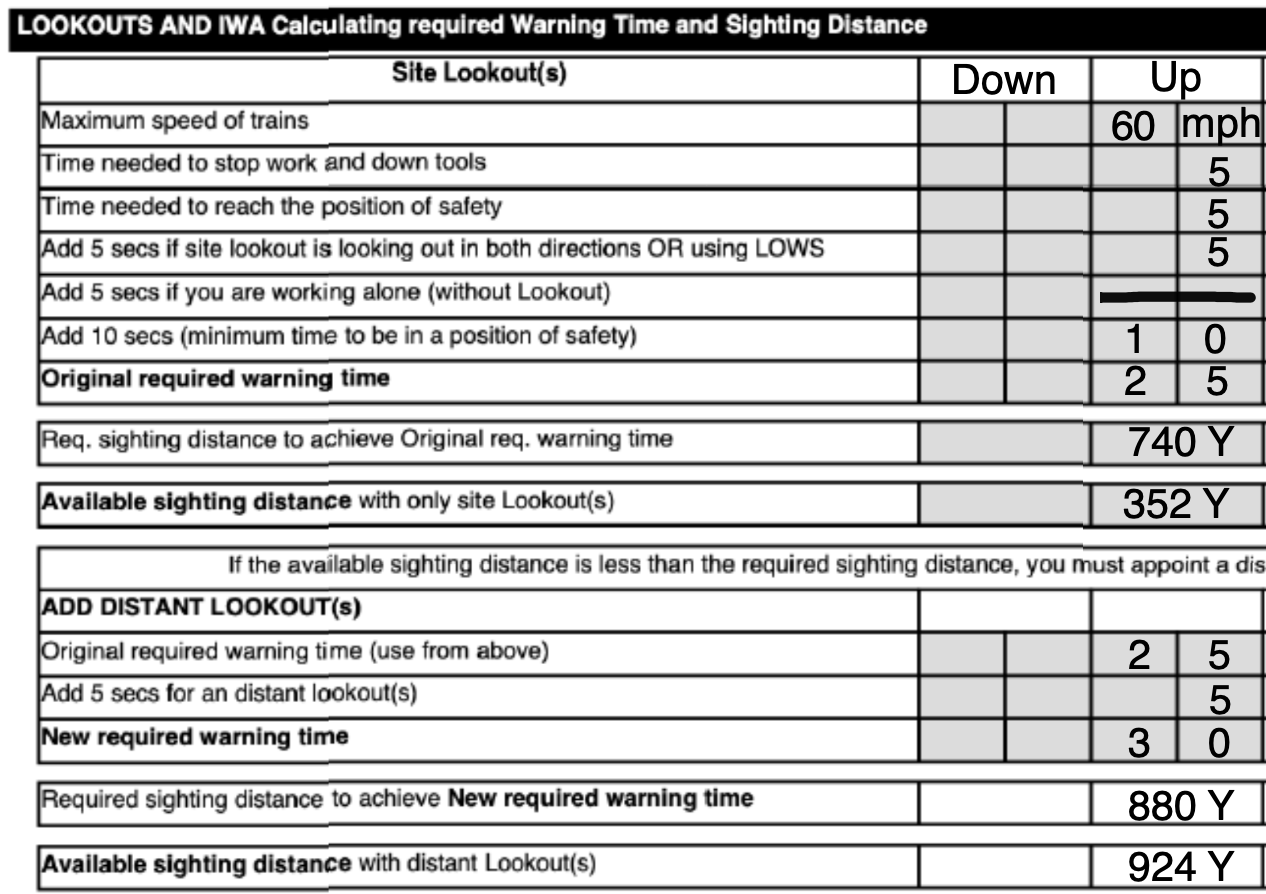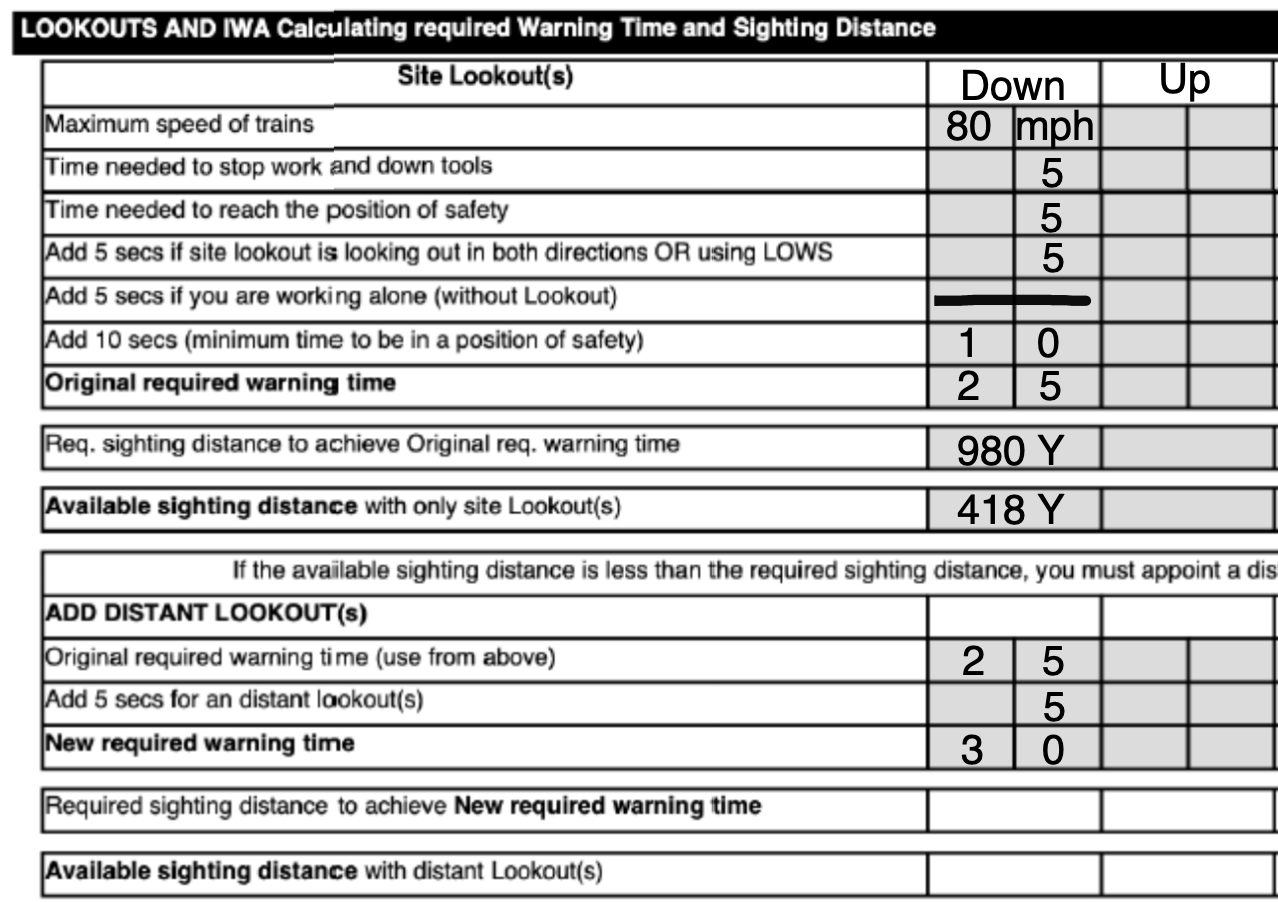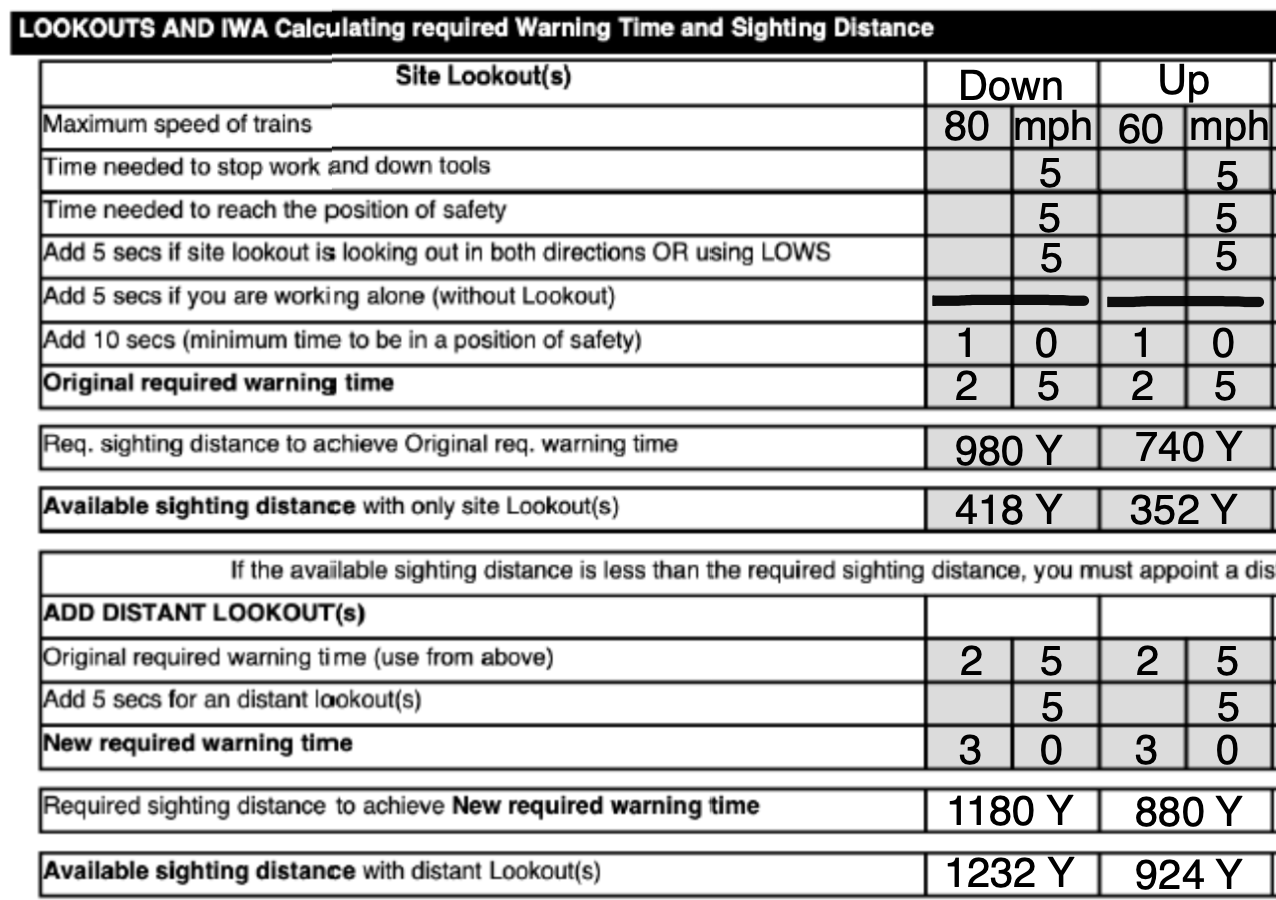Calculating Sighting Distances

Calculating Sighting Distances
The purpose of this revision test is to aid anyone trying to maintain, gain and improve their knowledge when it comes to calculating. This primarily designed for IWA's and COSS'. It is more for learning and practice rather than a test.
We recommend that you have a Sighting Distance Chart and a calculator available.
Sighting chart can be found in the COSS Keypoint Card or on our 'Exercises & Handouts' page.
We will start with a couple of questions then get into the calculations.
When calculating sighting distances you will be required to use a Sighting Distance Chart. This provides you with which of the following?
Required sighting distance
Available sighting distance
Which of these may impact your available sighting distance when on site?
Noise
Vegetation
Curvature of the track
Buildings and structures
People and vehicles
Weather (sun, rain, fog, etc.)
Darkness
PPE that the group needs
NOTE
Now we know a little bit about miles, chains, yards and metres.
If you already have an idea of how to calculate sighting distances that's great, just continue.
If not, we recommend you read out 'How to Calculate Sighting Distances Handout' that can be found on our website.

NOTE
Now we know a little bit about miles, chains, yards and metres.
If you already have an idea of how to calculate sighting distances that's great, just continue.
If not, we recommend you read out 'How to Calculate Sighting Distances Handout' that can be found on our website.

NOTE
Just so you know, this is the plan.
First, we will figure out distances within the same mile. Then once that's done, we will look at calculating these distances when we can see into the next or previous mile. As the technique to figure it out is a little different.
For both, we will start by calculating distances in chains. Then we will work on converting those chains into yards.
We'll do the Up line first, then the Down.
We will also look at using a Sighting Distance Chart to see if the available distance is enough.
NOTE
Just so you know, this is the plan.
First, we will figure out distances within the same mile. Then once that's done, we will look at calculating these distances when we can see into the next or previous mile. As the technique to figure it out is a little different.
For both, we will start by calculating distances in chains. Then we will work on converting those chains into yards.
We'll do the Up line first, then the Down.
We will also look at using a Sighting Distance Chart to see if the available distance is enough.
Calculate the available sighting distance.
Site of work: 3 miles 4 chains
Sighting Point: 3 miles 20 chains
(3 and a quarter milepost)
16 chains
26 chains
10 chains
46 chains
Let's say that the linespeed of the Up line is 60mph and you've added up to 25 seconds.
If you look at the Sighting Distance Chart you need a minimum of 740 yards, which we don't have.
Let's say that the linespeed of the Up line is 60mph and you've added up to 25 seconds.
If you look at the Sighting Distance Chart you need a minimum of 740 yards, which we don't have.
So you position a Distant Lookout at the quarter milepost and they can now see to a bridge at 3 miles and 46 chains.
What is the combined overall sighting distance?
Site of work: 3 miles 4 chains
Sighting Point: 3 miles 46 chains
42 chains
40 chains
26 chains
46 chains
Let's look at that again, but this time we are going to convert it into yards.
When we complete a Warning Time Calculation Sheet, we would normally use Yards or Metres so we need to end in that unit of measure.
Let's look at that again, but this time we are going to convert it into yards.
When we complete a Warning Time Calculation Sheet, we would normally use Yards or Metres so we need to end in that unit of measure.
What the Site Lookout could see was 16 chains. What is that in yards?
352 yards
320 yards
1200 yards
382 yards
What your Warning Time Calculation Sheet now looks like is this:

What your Warning Time Calculation Sheet now looks like is this:

Next, the Distant Lookout could see 26 chains, totalling 42 chains. How many yards is that in total?
Don't forget to put 'yards' at the end.
Imagine now that you have now looked to your left for trains approaching on the Down line. Calculate the available sighting distance into chains.
Site of work: 3 miles 4 chains
Sighting Point: 2 miles 65 chains
61 chains
19 chains
69 chains
39 chains
Which of the below is the correct way to calculate 19 chains into yards?
19 x 22 = 418y
19 x 80 = 1520y
19 x 1 = 19y
19 ÷ 22 = 0.86y
You've almost completed your Warning Time Calculation Sheet for the Site Lookout section. We now know that we have 418 yards available, but is that enough? Let's see.
What is the required sighting distance?
What is the required sighting distance?
Linespeed: 80 mph
Original Warnining Time: 25 seconds
Don't forget to put 'yards' at the end.
As your AVAILABLE sighting distance to the bridge is less than the REQUIRED sighting distance, you're now required to position your Distant Lookout.
So your Warning Time Calculation sheet should looks like this:

As your AVAILABLE sighting distance to the bridge is less than the REQUIRED sighting distance, you're now required to position your Distant Lookout.
So your Warning Time Calculation sheet should looks like this:

As you are having to add an additional lookout for the Down line at the bridge, what is your new required sighting distance according to this chart?
Linespeed: 80 mph
Original Warnining Time: 30 seconds
Don't forget to put 'yards' at the end.
{"name":"Calculating Sighting Distances", "url":"https://www.quiz-maker.com/QZCG49JQ3","txt":"Calculating Sighting Distances The purpose of this revision test is to aid anyone trying to maintain, gain and improve their knowledge when it comes to calculating. This primarily designed for IWA's and COSS'. It is more for learning and practice rather than a test. We recommend that you have a Sighting Distance Chart and a calculator available. Sighting chart can be found in the COSS Keypoint Card or on our 'Exercises & Handouts' page. We will start with a couple of questions then get into the calculations., When calculating sighting distances you will be required to use a Sighting Distance Chart. This provides you with which of the following?, Which of these may impact your available sighting distance when on site?","img":"https://www.quiz-maker.com/3012/CDN/97-4797635/sighting-chart-top-left.png?sz=1200-00000000000670305152"}
